GitOps with ArgoCD
ArgoCD Basics
Create ArgoCD Project
In this guide, you'll learn how to create a custom ArgoCD project that enforces specific restrictions on source repositories and cluster-level resources. We begin by reviewing the default project configuration, then move on to creating and configuring a custom project, and finally deploy and synchronize an application to validate the restrictions.
Reviewing the Default Project
Before implementing a custom project, it is important to understand how the default project is configured. The default project is highly permissive—it allows deployments to any destination and namespace without restrictions on source repositories or resources.
Run the following command to list the projects:
argocd proj list
The output will show that the default project accepts any source (*) and destination (*,*), with no restrictions on cluster-level or namespace-level resources:
NAME DESCRIPTION DESTINATIONS SOURCES CLUSTER-RESOURCE-WHITELIST NAMESPACE-RESOURCE-BLACKLIST SIGNATURE-KEYS ORPHANED-RESOURCES
default *i,* * */* <none> disabled
For clarity, here's another similar output:
argocd proj list
NAME DESCRIPTION DESTINATIONS SOURCES CLUSTER-RESOURCE-WHITELIST NAMESPACE-RESOURCE-BLACKLIST SIGNATURE-KEYS ORPHANED-RESOURCES
default *.* * */* <none> <none> disabled
Note
The default project does not limit which clusters or namespaces can be deployed to, nor does it restrict source repositories. This open configuration may not be suitable for every production environment.
Checking Applications and Projects
You may also want to verify the current applications and projects using the Kubernetes CLI within the ArgoCD namespace.
To list all applications:
k -n argocd get applications
Output:
NAME SYNC STATUS HEALTH STATUS
solar-system-app-2 Synced Healthy
To list the projects available in ArgoCD:
k -n argocd get appproj
Output:
NAME AGE
default 102m
Creating a Custom Project
Next, we will create a new custom project. This project will restrict allowed source repositories and control cluster-level resource deployment. You can create this project using either the UI or CLI. Below is the CLI output that shows the default state before introducing our custom project:
argocd proj list
NAME DESCRIPTION DESTINATIONS SOURCES CLUSTER-RESOURCE-WHITELIST NAMESPACE-RESOURCE-BLACKLIST SIGNATURE-KEYS ORPHANED-RESOURCES
default *,* * */* <none> disabled
Additionally, review the current applications and projects:
k -n argocd get applications
NAME SYNC STATUS HEALTH STATUS
solar-system-app-2 Synced Healthy
k -n argocd get appproj
NAME AGE
default 102m
Configuring the Custom Project via the UI
To start, open the ArgoCD user interface and navigate to the Projects configuration via the sidebar. You will see the default project configuration listed. Click on "Create a new project" to begin setting up your custom project, for instance named "special-project". Provide a clear description outlining the restrictions that will be applied.
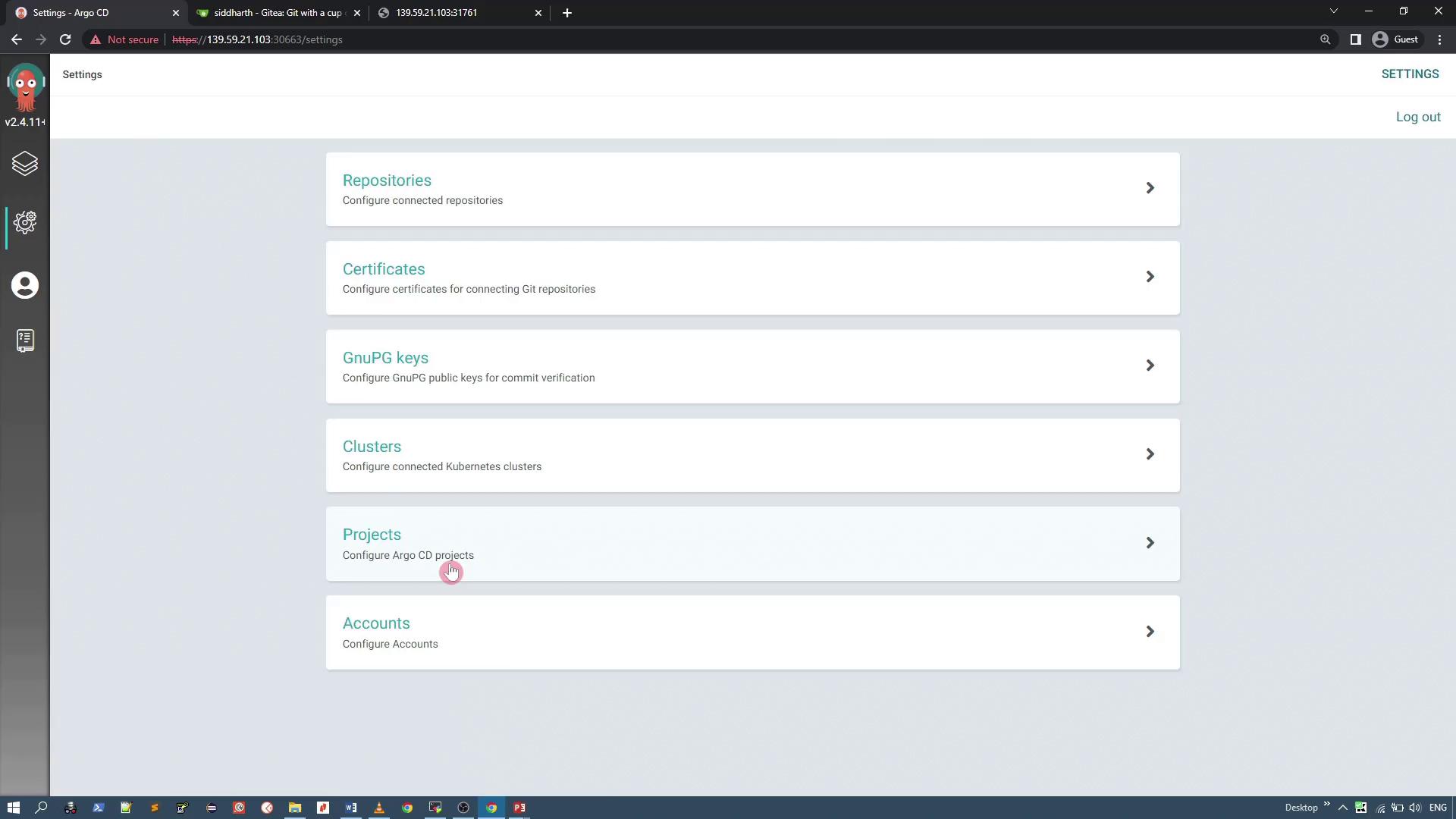
Setting Source Repository Restrictions
Within the project settings, limit the allowed source repositories by replacing the default wildcard (*) with the specific Git repository URL containing the pod metadata resources. For example, allow only the "pod metadata" repository:
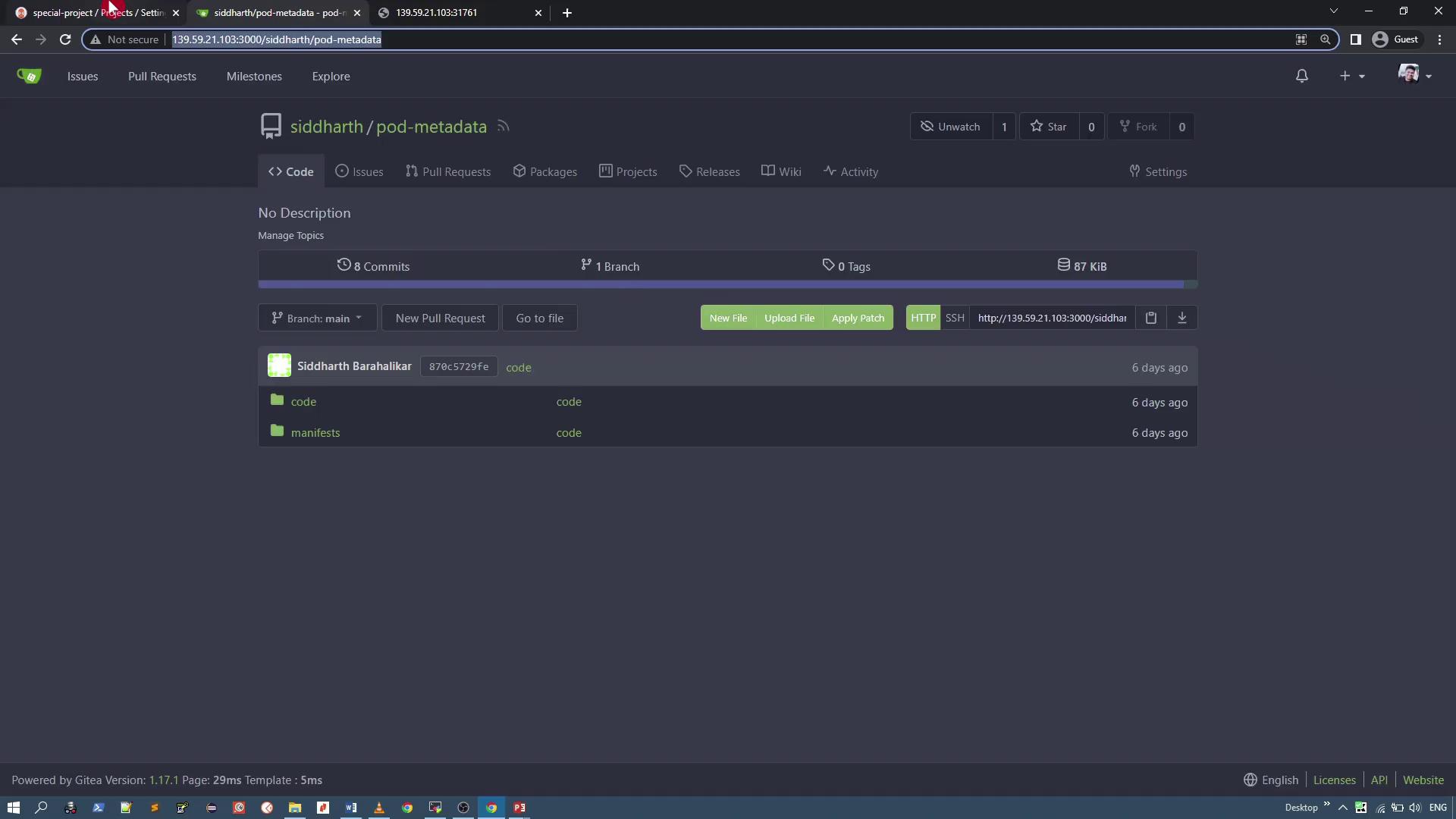
Defining Deployment Destinations
Under the Destinations section, restrict deployments to the current cluster by specifying its server URL (e.g., https://kubernetes.default.svc). You may keep the namespace wildcard (*) to allow flexible namespace usage.

Configuring Resource Denial
To enhance security, configure the project to deny certain cluster-level resources. In this example, we restrict ClusterRole resources to prevent unauthorized full-access permissions. Suppose you have a manifest for a ClusterRole resource as shown below:
apiVersion: rbac.authorization.k8s.io/v1
kind: ClusterRole
metadata:
creationTimestamp: null
name: pod-master
rules:
- apiGroups:
- ""
resources:
- pods
verbs:
- "*"
Add an entry to the project’s deny list for ClusterRole resources. When editing, select "ClusterRole" as the kind and leave the group field empty.
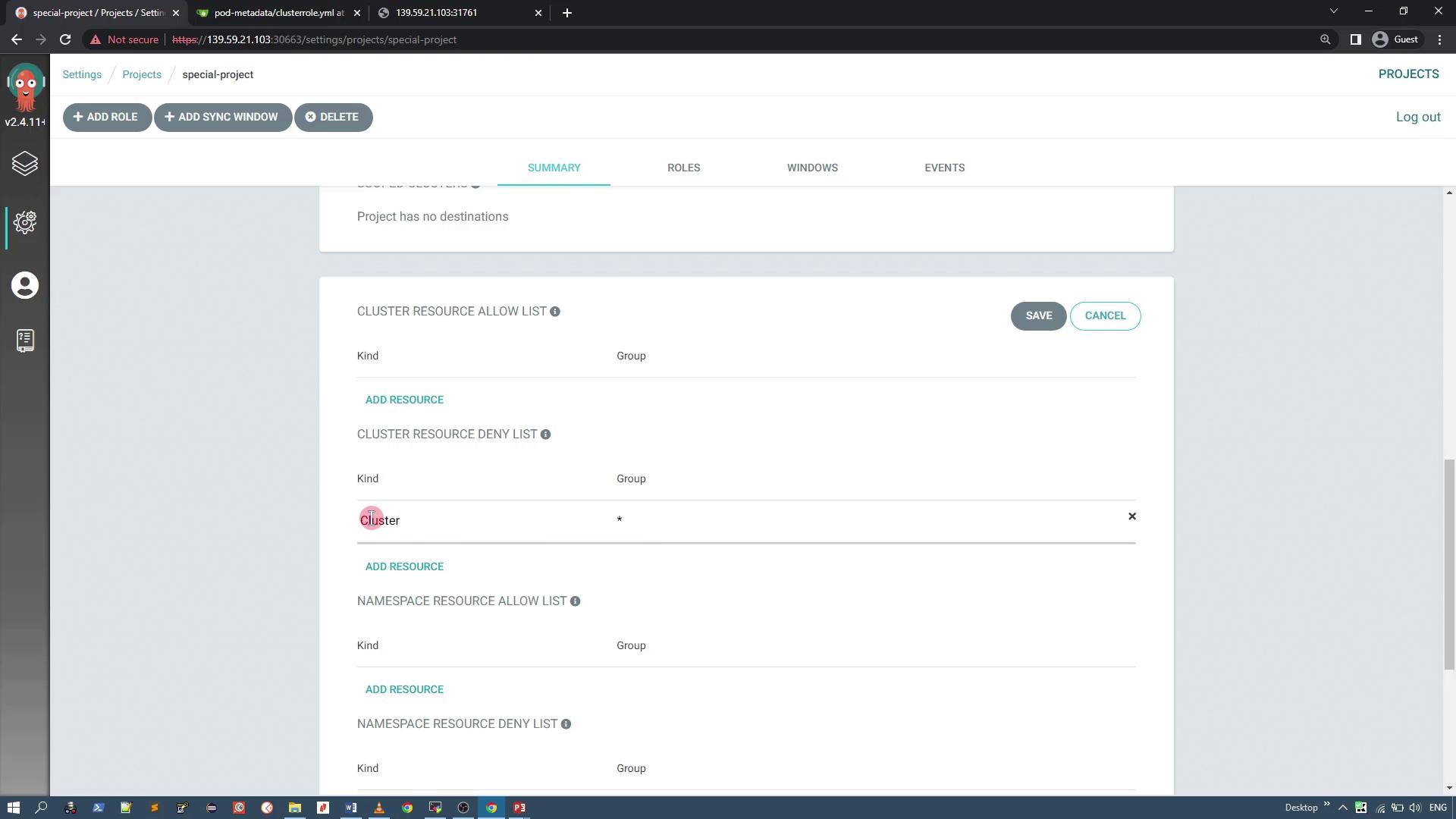
After saving your settings, view the new project summary in the UI:
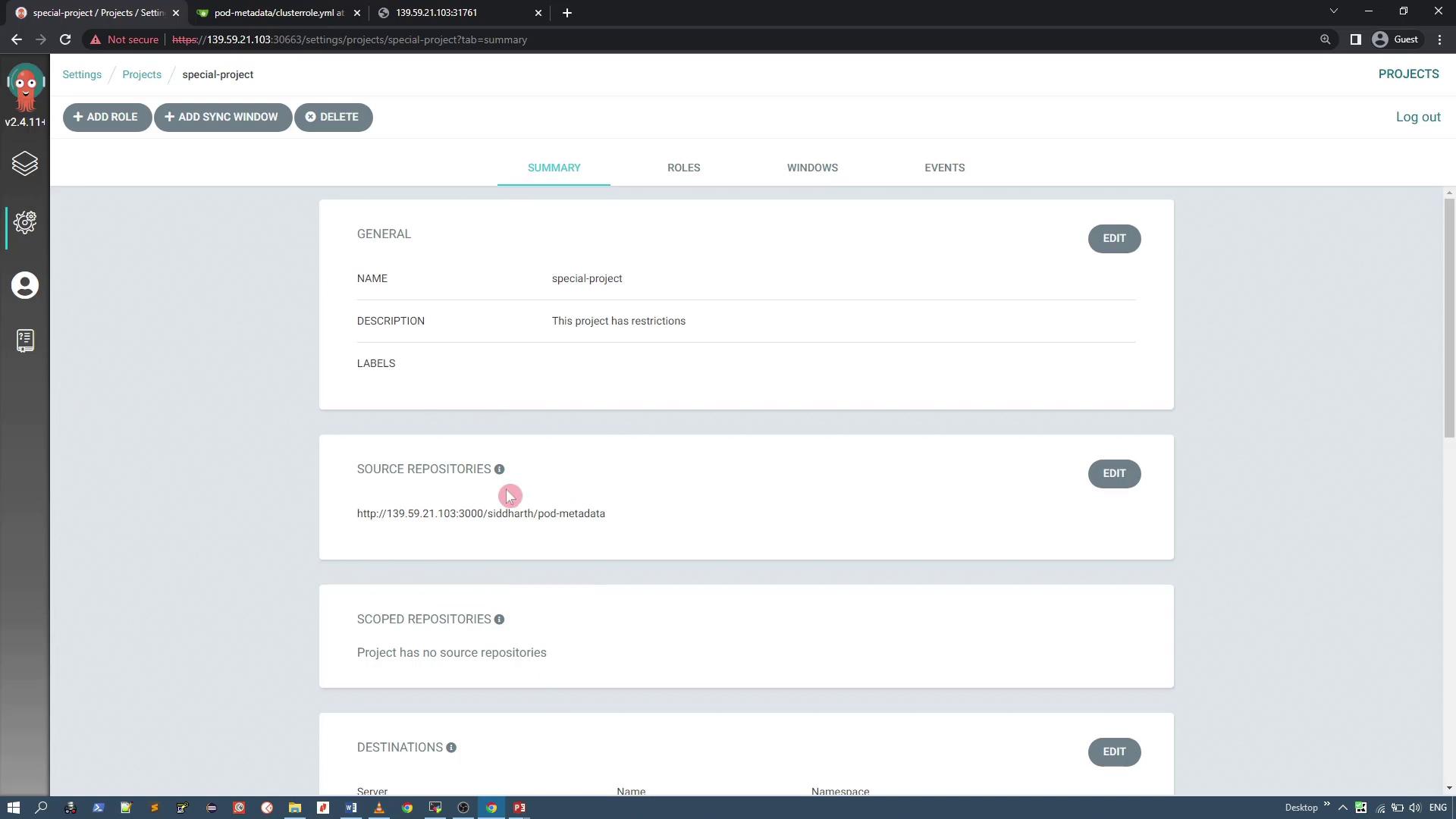
Verifying the Custom Project via CLI
After configuration, verify that the new "special-project" has been created alongside the default project using:
argocd proj list
Expected output:
NAME DESCRIPTION DESTINATIONS SOURCES CLUSTER-RESOURCE-WHITELIST NAMESPACE-RESOURCE-BLACKLIST SIGNATURE-KEYS ORPHANED-RESOURCES
default /* *,* * /* /* <none> disabled
special-project This project has restrictions https://kubernetes.default.svc,* http://139.59.21.103:3000/siddharth/pod-metadata <none> disabled
To view detailed configuration in YAML format, run:
argocd proj get special-project -o yaml
Below is an example snippet of the YAML output:
metadata:
creationTimestamp: "2022-09-23T15:44:52Z"
generation: 4
name: special-project
namespace: argocd
spec:
clusterResourceBlacklist:
- group: ''
kind: 'ClusterRole'
description: This project has restrictions
description: This project has restrictions
destinations:
- name: in-cluster
namespace: '*'
server: https://kubernetes.default.svc
sourceRepos:
- http://139.59.21.103:3000/siddharth/pod-metadata
status: {}
Verify these settings again after any updates with:
argocd proj get special-project -o yaml
Important
Ensure that all fields are correctly populated. For instance, an empty group field for a ClusterRole should be represented properly in YAML quotes.
Creating and Testing an Application with the Custom Project
Now, create an application that is associated with the "special-project" custom project. When creating the application (e.g., "special-pod-app"), verify that the connected repository is correct. Note that the application sync policy should be set to manual and the namespace will be auto-created if necessary.
If you try deploying an application from a disallowed repository, an error will appear similar to the following:
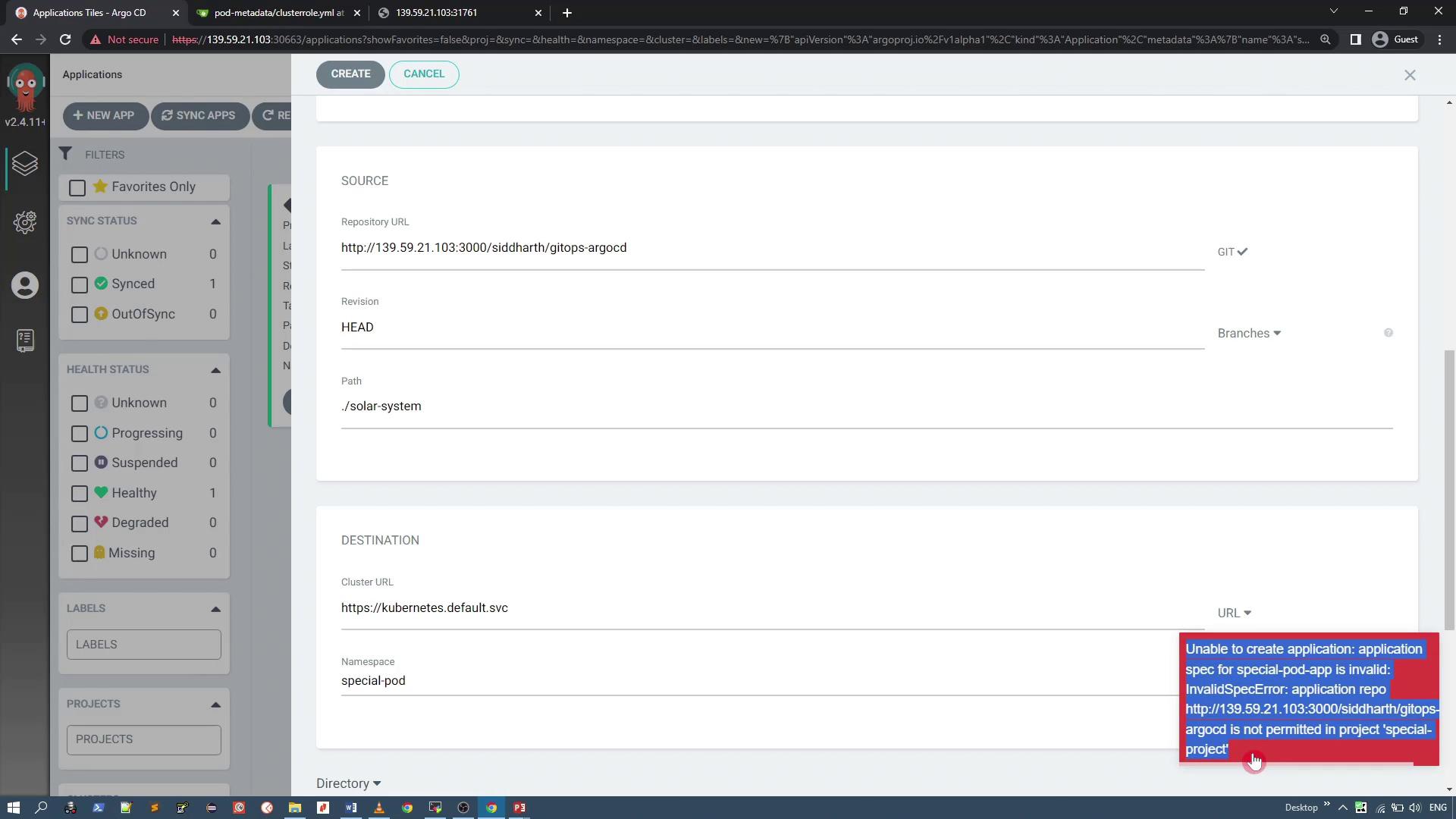
Once you select the approved pod metadata repository and set the application manifest path (e.g., "manifest"), click "Create." The application should now appear in the dashboard.
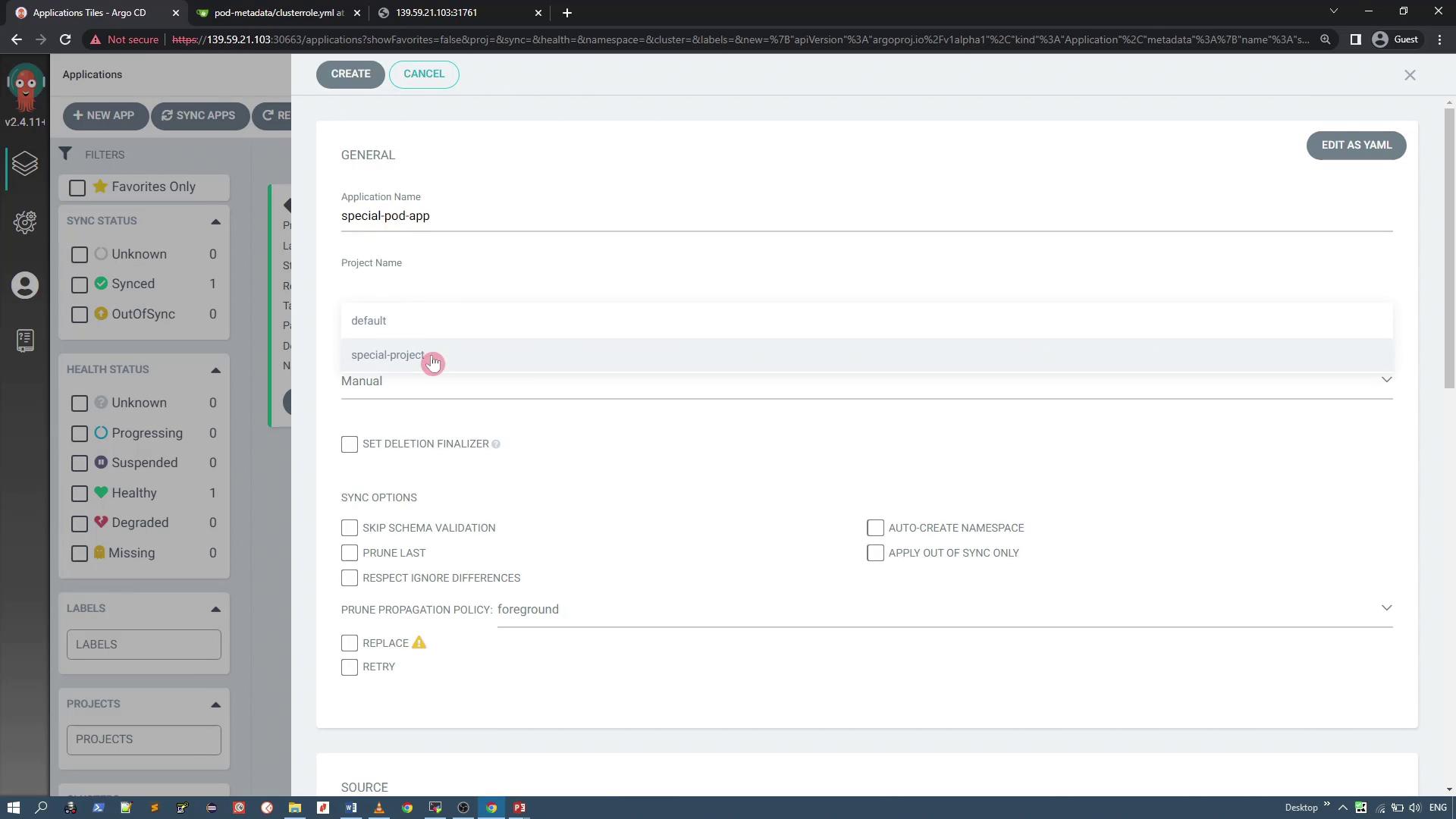
The ArgoCD dashboard will display both "special-pod-app" and the previously existing "solar-system-app-2":
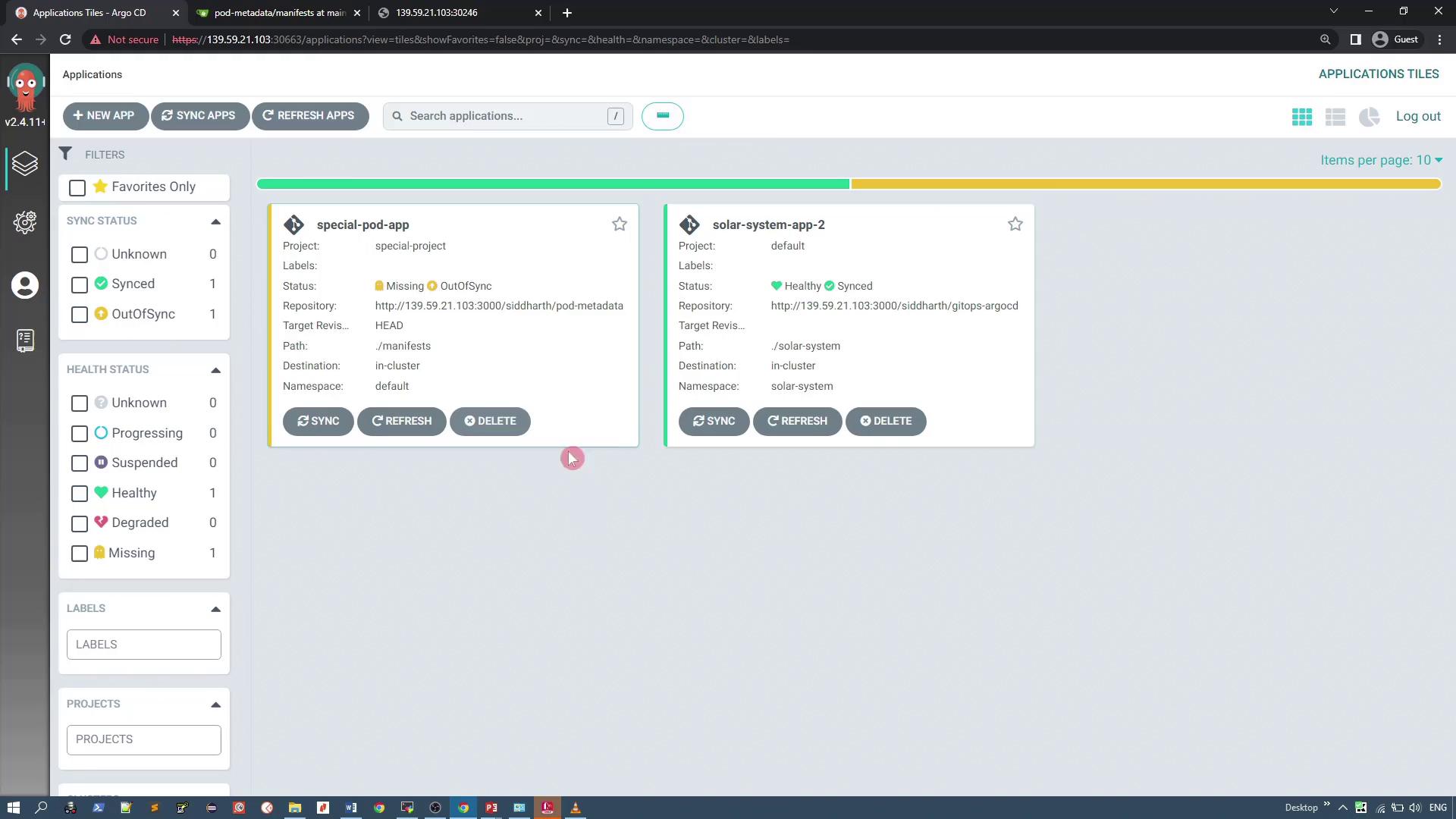
Synchronizing the Application and Handling Denied Resources
To deploy the application, click "Sync" for "special-pod-app." During synchronization, ArgoCD will try to apply all resources defined in the repository—including a ClusterRole resource. Since the custom project denies ClusterRole resources, the sync will fail with an error indicating that the resource is not permitted.
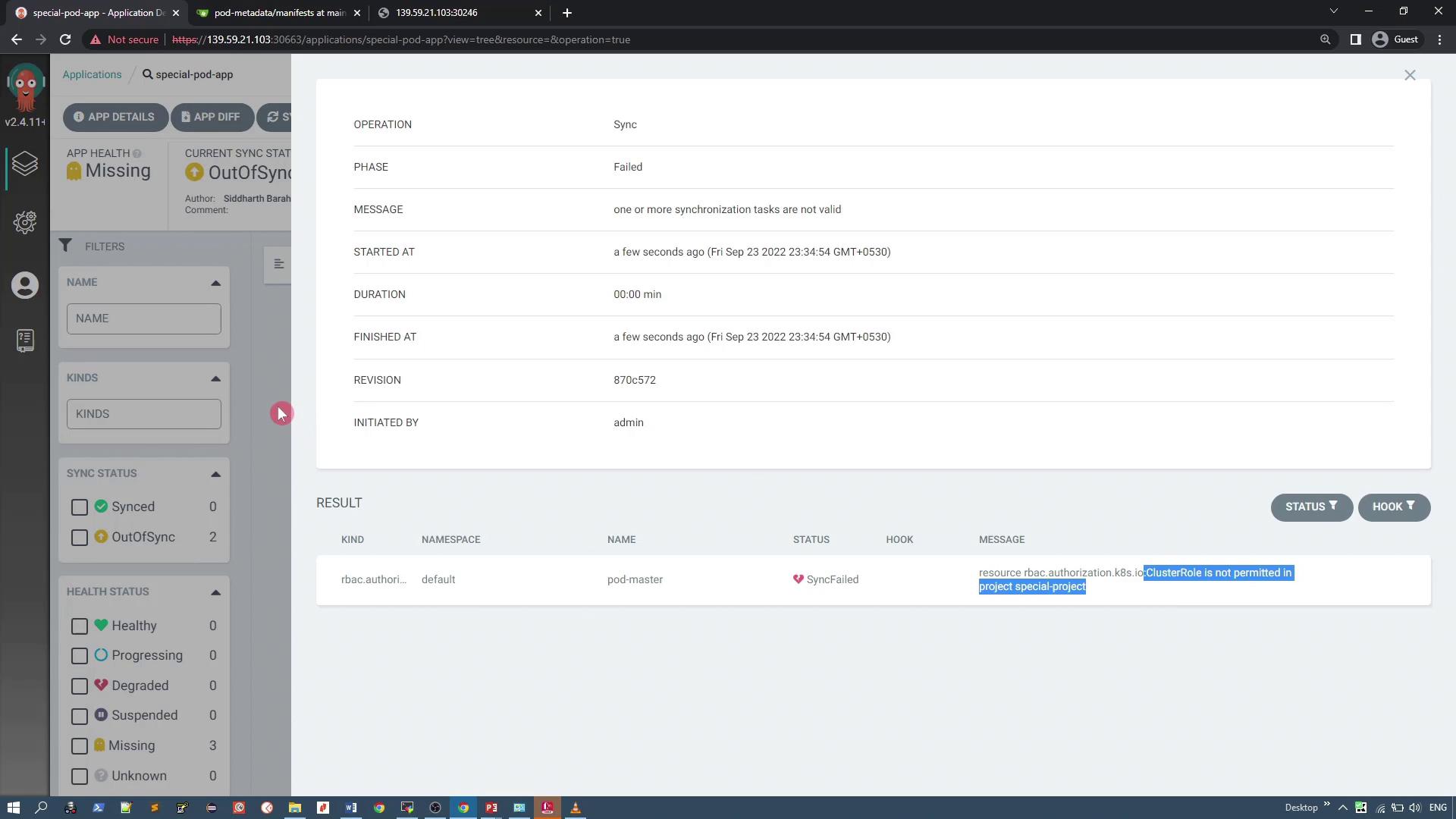
To resolve this, deselect the ClusterRole resource during the sync operation. This will deploy the remaining resources (the deployment and service) successfully. After resynchronizing, "special-pod-app" should deploy the pod metadata application and expose it via the configured service.
Application Details
Upon successful synchronization, the application deploys a simple PHP application that displays pod details (such as pod IP, pod name, UID, CPU requests, etc.) using the Kubernetes Downward API.
For reference, here is part of the deployment manifest:
replicas: 1
revisionHistoryLimit: 10
selector:
matchLabels:
app: pod-metadata
strategy:
rollingUpdate:
maxSurge: 25%
maxUnavailable: 25%
type: RollingUpdate
template:
metadata:
labels:
api: downward
app: pod-metadata
env: dev
usage: global
spec:
containers:
- name: test-container
env:
- name: MY_NODE_IP
valueFrom:
fieldRef:
fieldPath: status.hostIP
- name: MY_POD_ID
valueFrom:
fieldRef:
fieldPath: status.podIP
- name: MY_POD_UID
valueFrom:
fieldRef:
fieldPath: metadata.uid
- name: MY_CPU_REQUEST
valueFrom:
resourceFieldRef:
containerName: test-container
resource: requests.cpu
- name: MY_CPU_LIMIT
valueFrom:
resourceFieldRef:
containerName: test-container
resource: limits.cpu
The following service manifest exposes the application via a node port (e.g., 32651):
apiVersion: v1
kind: Service
metadata:
annotations:
kubectl.kubernetes.io/last-applied-configuration: |
{"apiVersion":"v1","kind":"Service","metadata":{"annotations":{},"labels":{"app":"pod-metadata"},"name":"pod-metadata-service","namespace":"default"},"spec":{"clusterIP":"10.107.42.62","clusterIPs":["10.107.42.62"],"externalTrafficPolicy":"Cluster","internalTrafficPolicy":"Cluster","ipFamilies":["IPv4"],"ipFamilyPolicy":"SingleStack","ports":[{"nodePort":32651,"port":80,"protocol":"TCP","targetPort":80}],"selector":{"app":"pod-metadata"}}}
creationTimestamp: "2022-09-23T18:05:38Z"
labels:
app: pod-metadata
name: pod-metadata-service
namespace: default
spec:
clusterIP: 10.107.42.62
clusterIPs:
- 10.107.42.62
externalTrafficPolicy: Cluster
internalTrafficPolicy: Cluster
ipFamilies:
- IPv4
ipFamilyPolicy: SingleStack
ports:
- nodePort: 32651
port: 80
protocol: TCP
targetPort: 80
selector:
app: pod-metadata
After deployment, access the application via node port 32651 to view pod details, including pod name, IP, UID, host IP, and other metadata retrieved via the Downward API.
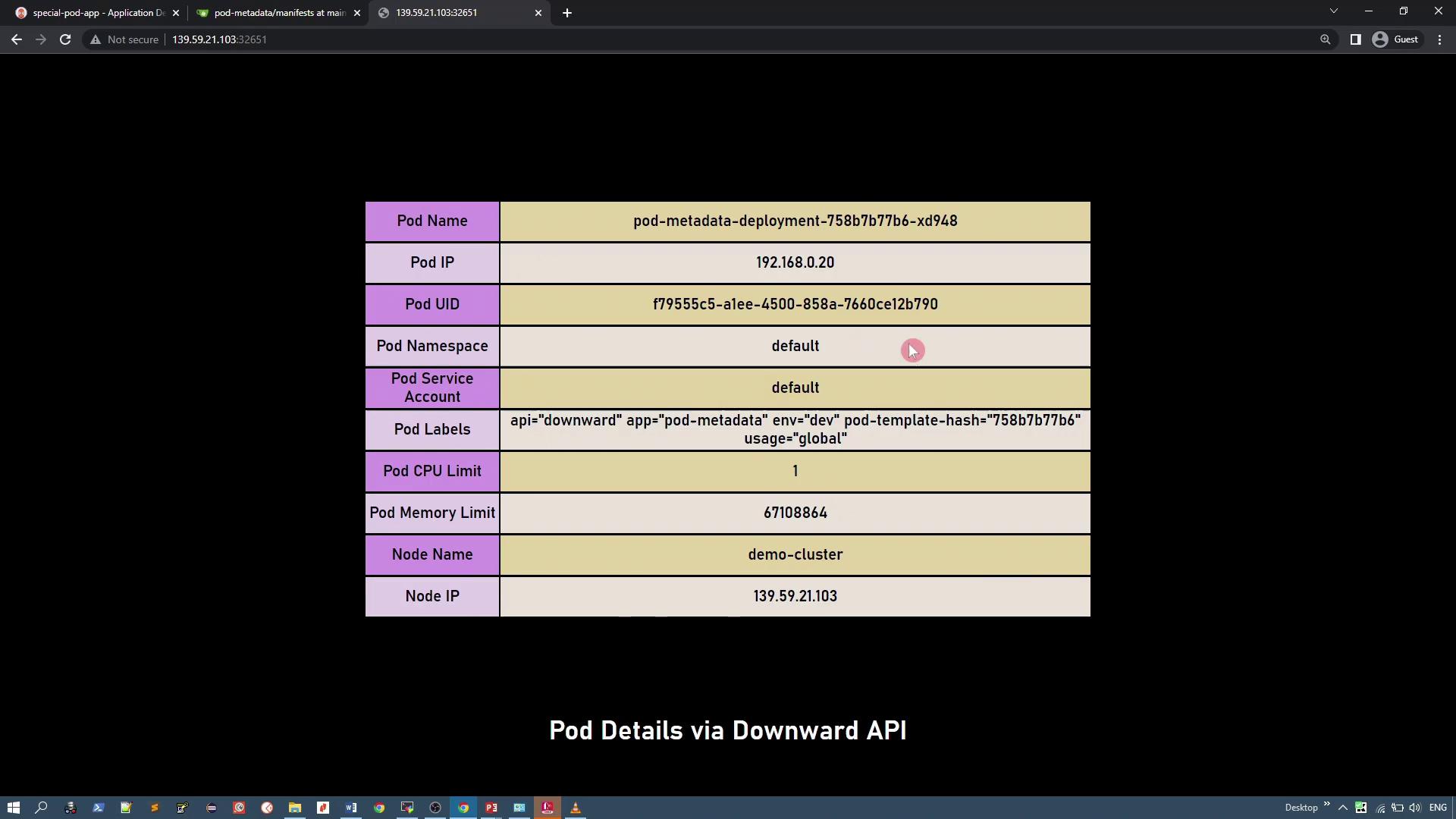
Summary
In this lesson, you have learned how to:
- Review the default ArgoCD project configuration.
- Create a custom project with restrictions on source repositories and cluster-level resource deployment.
- Configure project settings via the UI by whitelisting an approved repository and denying ClusterRole resources.
- Deploy an application using the custom project, address synchronization errors due to denied resources, and verify a successful deployment of allowed resources.
Implementing project restrictions in ArgoCD allows you to enforce fine-grained control over application deployments, ensuring that only authorized resources and repositories are used.
Thank you.
Watch Video
Watch video content
Practice Lab
Practice lab